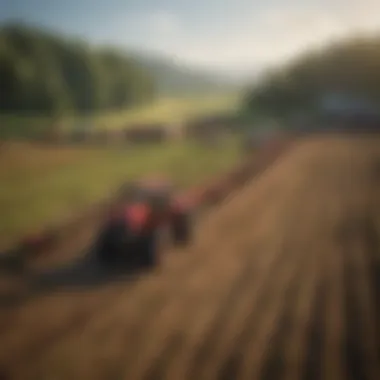The Farm Rescue Saga: Overcoming Modern Agricultural Challenges


Intro
Farming today is not just about tilling the soil and planting crops. It involves confronting a range of challenges that can threaten not only the productivity of farms but also their sustainability. This multi-dimensional reality includes economic strains, environmental pressures, and technological advancements that require constant adaptation. The essence of modern farming lies in recognizing these hurdles and implementing strategies effectively to navigate them.
In this continously changing agricultural landscape, farmers often find themselves in a resulting 'rescue' scenario. They must adapt quickly to new regulations, market demands, and climate uncertainties. The discussion here seeks to clarify these major issues and showcases how tailored strategies can cultivate resilience within farming communities.
Understanding these dynamics is critical for stakeholders at all levels, from policymakers to farming producers and consumers. It highlights not only the struggles directly tied to cultivation but also the associated socio-economic impacts. Strategies may vary widely, but the ultimate goal remains similar: maximizing output while preserving the integrity of farming practices.
As we delve into the analysis, readers can expect a succinct exploration of real-life case studies, integrates various elements influencing agriculture today, including community support, innovation, and policies in place that shape farming’s future. This investigation is pivotal in offering actionable insights that can facilitate lasting change in the agricultural sector.
By striving toward sustainable practices, we illuminate the path forward for agriculture, instilling hope and igniting moghts among our farmers, aiding in the critical transitionnable phase of farming’s narrative. This saga of farm rescue is vital not just for those in agriculture but also for society as a whole—a collective understanding leads to informed decision-making that ensures a more resilient and sustainable future.
Prologue to the Farm Rescue Saga
The current agricultural landscape is complex and filled with challenges that compel farming operations to seek innovative methods to manage crises. Understanding these challenges is essential for anyone interested in the modern dynamics of agriculture. The Farm Rescue Saga will explore strategies that help farms adapt and thrive amidst difficulties. This exploration is not just about immediate interventions; it involves grasping the broader facets that make up the farming community.
Defining Farm Rescue
Farm rescue can be defined as a range of actions or interventions aimed at supporting struggling agricultural operations. This support might come in various forms such as financial assistance, technical support, or collaboration among different stakeholders. A critical understanding of farm rescue includes recognizing its role in ensuring food security while promoting sustainable practices. Additionally, stakeholders can positively influence the agricultural sector by understanding failures and implementing strategies for success.
Key Aspects of Farm Rescue:
- Financial aid to farmer's dealing with economic stress.
- Technical support to adopt new sustainable techniques.
- Facilitation of community involvement in problem-solving efforts.
- Training programs that equip farmers with necessary tools.
Historical Context
To contextualize farm rescue effectively, it is beneficial to look into its historical precedence. Agriculture has continually faced disasters caused by climate, pests, and market fluctuations over the years. Historical events shaped policies and community responses to agricultural crises significantly. By examining the past challenges, it is possible to identify patterns and responses that still resonate today.
Farms have historically relied on localized solutions, underscoring the importance of community. Government resources were limited, often resulting in fragmented assistance frameworks. As we saw during the Great Depression, widespread desperation necessitated major advancements in policy and community support.
- The agricultural crisis led to the establishment of cooperative farms.
- Neighbors worked together to support one another.
- Relief organizations emerged, solidifying the need for collaborative action.
Understanding this context is vital for emulating successful strategies from the past and avoiding repeated errors. It provides insights into resilience factors that can inspire current stakeholders to navigate contemporary challenges adeptly. As we engage with farm rescue today, knowing historical burdens poses recurrent difficulties. This deep dive sets the stage for innovating sustainable farming practices which aligns modern solutions with time-tested lessons.
The Socio-Economic Factors
Understanding the socio-economic factors in agriculture is essential because they intertwine with the viability and sustainability of farming operations. These elements embody the financial and societal structures that dictate how farms perform under various circumstances. The implications of socio-economic conditions reach deep, affecting everything from the resource availability to the strength of community support. The considerations in this area can lead to pivotal outcomes in farm management, ultimately impacting yield and quality of life for all involved.
Impact of Market Trends
Market trends exert a significant influence on farming practices and decisions. Global market dynamics shape what products are worthwhile to cultivate, which directly influences farmers' choices. An increase in demand for organic produce, for example, prompts traditional farmers to adapt their practices. Making informed choices can mean the difference between market success and failure.
Key aspects related to market trends include:
- Consumer Preferences: As consumers gravitate toward healthy and local foods, farmers are pushed to adapt their production.
- Price Volatility: Fluctuations in commodity prices can create economic insecurity, which may force farmers to adjust their operations.
- Globalization: The increasing interdependence of global markets necessitates an understanding of international demand and supply relations.
Keeping abreast of these trends helps farmers formulate effective strategies that safeguard them against adverse shocks.
"The responsiveness to market changes could boost not only a farm's profitability but also its operational sustainability."


Rural Community Dynamics
The dynamics within rural communities play a crucial role in the socio-economic aspects of farming. Strong community ties can foster resilience and adaptability. On the other hand, weak community structures may lead to disarray and a lack of support for local farmers.
Important elements of rural community dynamics include:
- Social Networks: Relationships among community members often encourage resource sharing, education, and emotional support during challenging times.
- Local Infrastructure: Access to facilities like markets, banks, and schools significantly impacts farm viability. Good infrastructure enhances productivity.
- Policy Frameworks: Local policies shape agricultural practices and can either exacerbate or alleviate the challenges faced by farmers.
Understanding the nuances of rural community dynamics helps stakeholders recognize the interconnected nature of farming and societal wellbeing.
Environmental Considerations
In the realm of modern farming, environmental considerations are increasingly crucial. They not only reflect the profitability of agricultural operations but also illustrate their thriving coexistence with natural ecosystems. Ensuring sustainable practices helps maintain soil health, water quality, and biodiversity, critical aspects of agriculture that often get overlooked.
Ecosystem Preservation
Ecosystems are complex networks where every organism plays a vital role. Preservation of these systems within farming is essential to maintaining productivity and sustainability. Drawbacks to ecosystems, whether from pollution or habitat destruction, can result in diminished returns for farmers. Practices need to include careful management of inputs such as pesticides and fertilizers which can harm local flora and fauna.
Effective strategies such as crop rotation, cover cropping, and agroforestry can enhance ecosystem function. These methods foster soil biodiversity, aiding in natural pest control and nutrient cycling. Maintaining biodiversity within the farm not only improves resilience against pests and diseases but also sustains environmental health.
“Healthy ecosystems underpin any long-term agricultural success. Without them, soils degrade, pests flourish, and the ultimate ability to produce deteriorates.”
Climate Change Effects
Climate change poses profound threats to agriculture. Extreme weather, including floods, droughts, and unpredictable seasons, alters the landscape of farming operations. Each phenomenon disrupts the delicate balance that sustains crops, ultimately influencing yields and profitability. Farmers must adapt their practices to meet these challenges to safeguard their livelihoods.
Innovative techniques, such as precision farming, harness technology to conserve resources. By monitoring weather patterns and soil conditions, farmers can optimize water use and reduce input costs. This participatory approach aids in creating long-term strategies that correlate with real-time data, leading to more informed decision making.
Farmers should also champion soil health as a climate response mechanism. Practices like improved composting, minimal tillage, and agroecological methods are key to sequestering carbon and increasing the fertility of the soil.
Technological Innovations
Technological innovations play a crucial role in transforming modern agriculture. They not only enhance productivity and efficiency but also pave the way for sustainable practices in farming. With challenges ranging from shifting climate patterns to economic pressures, the adoption of new technologies has become essential for the survival and growth of farms.
In this article, we explore advancements within two key areas of technological innovations: advancements in farming equipment and data management tools. Each of these subtopics offers unique benefits and considerations that reshape the agricultural landscape.
Advancements in Farming Equipment
Significant improvements in farming equipment have the potential to revolutionize traditional practices. Noteworthy advancements include the development of precision agriculture tools, autonomous tractors, and smart irrigation systems.
- Precision Agriculture: This approach uses GPS and IoT technology to provide real-time data about crop health, soil moisture, and nutrient levels. Subsequently, farmers can make informed decisions to optimize yield and reduce waste.
- Autonomous Tractors: Tractors equipped with automation can work more extended hours without operator intervention. This leads to increased productivity and efficiency. Autonomy allows for more strategic planning of farming activities, reducing labor costs.
- Smart Irrigation Systems: Adopting advanced irrigation techniques can minimize water usage. Sensors detect moisture levels, ensuring crops receive adequate hydration without wastage. This technology is especially beneficial in arid regions dealing with water scarcity.
While the investment in these technologies may seem high initially, the long-term benefits often outweigh costs. By increasing efficiency and minimizing resources, these advancements contribute to a more sustainable future for farming.
"Adopting these innovations can significantly reduce a farm's operational costs and environmental footprint, ensuring better profitability and planetary health."
Data Management Tools
With decoded data at the core of modern adaptive strategies, the emergence of data management tools marks a significant shift in how farms operate. Farmers today collect vast amounts of information from various sources. Transforming that data into actionable insights is what sets successful farms apart.


- Farm Management Software: This includes applications that help farmers plan, monitor, and analyze all activities on their farms. With data consolidation, farmers can fine-tune their operations for optimal productivity.
- Remote Sensing Technology: Aerial imagery or satellite data helps farmers monitor crop performance across large areas. This technology informs decisions on irrigation practices and pest control.
- Big Data Analytics: By analyzing historical data and patterns, farmers can predict future trends. All aspects of the farming cycle from planting to harvest are optimized, reducing uncertainties.
Real-Life Case Studies
Real-life case studies provide invaluable insight into the realities of agricultural challenges and specific solutions that have been implemented. These case studies offer more than just data; they bring to life the stories of farmers facing adversity and experimenting with innovative approaches. By analyzing both successful and failed rescue scenarios, we can extract vital lessons that help shape future practices.
Successful Rescue Scenarios
Successful rescue scenarios often highlight crucial strategies that integrate various components of sustainable farming. For instance, a well-documented example is the program initiated by Farm Aid.org, which aims to support struggling farmers through financial assistance and educational resources. During the 2020 drought, several farms in the Midwest that utilized precise irrigation techniques saw substantial crop yields despite adverse weather conditions.
Those who integrated technology into their farming operations, like utilizing precision agriculture technology, experienced improvements in productivity and resource management. By employing tools like soil moisture sensors, they could manage irrigation more efficiently. This scenario emphasizes the importance of lightweight, user-friendly tech in enhancing resilience in farming.
“While unexpected risks are prevalent, the adaptation displayed by modern farmers illustrates the potential for innovation.”
Moreover, community partnerships played a significant role in several successful interventions. Local co-ops have helped struggling farmers by providing support networks. Community Land Trusts have been key to helping farmers access land, financial support, and emergency resources. Such collaboratives enhance resilience capabilities.
Lessons Learned from Failures
However, the farming path is not without its impediments. Looking at failed rescue attempts reveals areas needing improvement. One case in which a farming cooperative failed to deliver crucial supplies during a pest outbreak teaches us the necessity of effective communication. In such situations, gaps in the logistics chain lead to increased losses across multiple farms.
In the case of a dairy farm that failed to anticipate market fluctuations, it can be observed that overreliance on a single crop was detrimental. Many learned that diversification is essential. Governments even encouraged policies enabling farmers to pivot quickly when unexpected market changes occur.
Additionally, initiatives promoting integrated pest management were often ineffective without proper training for users in some scenarios. This reinforces the necessity of not just providing resources but also ensuring proper guidance in using them effectively. All these failures shed light on the need for continuous education, adaptability, and collaboration.
In summary, real-life case studies embody the lessons and successes in modern farming while offering deeper understanding of potential pitfalls. They demonstrate the essence of community integration and individual adaptability when navigating farm-related challenges.
Community and Policy Support
Community and policy support are pivotl in the nexus of modern farming. These factors can directly impact the sustainability and resilience of agricultural operations. In the context of farm rescues, the role of supportive communities and effective governance becomes even more critical. Fostering such support enhances local farming ventures that often operate in challenging suboptimal conditions.
The significance of community support lies in its multifaceted benefits. Local organizations can mobilize resources, offer education, and provide a network for struggling farmers. This solidarity helps build a sense of belonging, encouraging farmers to share resources and strategies for coping with adversity. Furthermore, it strengthens local economies by keeping operations viable.
Role of Local Organizations
Local organizations are the backbone of community support in agriculture. They play myriad roles in assisting farmers, both emotionally and practically. Many of these organizations aim to improve agricultural practices and erase challenges farmers encounter.
A few critical responsibilities include:
- Education and Training: Providing workshops on best farming practices, pest management, and sustainable agriculture.
- Resource Allocation: Establishing programs to distribute essential supplies like seeds or fertilizers to farmers in need.
- Advocacy: Representing farmers' interests to local government entities, ensuring their concerns and suggestions are voiced.
- Community Events: Organizing fairs or farmer’s markets, helping local farms reach their customers directly.
Too often, local organizations face resource constraints yet remain determined to support their farming communities through resilient programming. Their function extends beyond immediate aid to foster long-term sustainability for farming practices.
Government Policies and Regulations
Government action significantly affects the support for rural communities and farms. Relevant policies can shape agricultural landscapes, directing resources and assistance where they are required the most. Policy decisions can support or hinder farming success and endpoint sustainability.
Some essential elements of government policy include:
- Subsidies and Grants: Targeted financial assistance to struggling farmers is necessary. Such support facilitates innovation and the adoption of sustainable practices.
- Regulatory Frameworks: Legislation outlines environmental protocols, impacting farming practices significantly. Compliance is essential for farmers to utilize financial support.
- Emergency Relief Programs: In times of crisis, such as natural disasters or market crashes, government support helps stabilize local economies.
- Research Promotion: Encouraging agricultural research and development can lead to strong innovative solutions for issues like irrigation and pest management.


Government policies directly influence farming operations. Investing in supportive policies can elevate both rural economies and sustainable practices.
Thus, the interplay between local organizations and government interference shapes the landscape for farming. Their synergy could represent a blueprint for navigating the hardships faced in contemporary farming. This partnership offers promising prospects for future resilience in times of crisis.
The Future of Farming Rescues
Emerging Challenges
Farming rescues must address contemporary issues that impact the agricultural sector effectively. The ever-evolving landscape presents challenges that are interlinked with various socio-economic and environmental factors. For instance, climate change leads to extreme weather conditions which can devastate crops and disrupt agricultural productivity.
Another emerging challenge is the loss of arable land due to urbanization and industrial development. This phenomenon exerts further pressure on farming operations, pushing them into areas with less fertile soil. Moreover, labor shortages complicate the situation. Aging farmer demographics contribute to a decline in skilled workers.
Other pertinent challenges include:
- Market Volatility: The price fluctuations in crops affect farm revenue stability.
- Biodiversity Loss: This decreases ecosystem resilience and reduces productive capacity.
- Economic Downturns: These can lead to reduced investment in agriculture.
- Technological Disparity: The digital divide impacts small and medium-sized farms, limiting their access to advanced solutions that could improve efficiency.
Such obstacles demand innovative and strategic framework to support farming rescues. Addressing these issues is intrinsic to ensuring sustainable agricultural practices.
Innovative Solutions on the Horizon
To confront the challenges faced by modern farms, innovative solutions are occurring across the agricultural landscape. First and foremost, precision agriculture utilizes advanced technologies like satellite imaging, drones, and IoT devices to provide real-time data. This helps farmers make informed decisions regarding resource allocation and crop management.
Additionally, sustainable farming practices gain traction. Strategies such as crop rotation, cover cropping, and agroforestry create healthier soil and promote biodiversity.
Furthermore, collaboration between stakeholders is crucial. Local organizations, universities, and tech companies can work together to share expertise and resources effectively.
Noteworthy solutions include:
- Vertical Farming: Using less space while ensuring controlled environments conducive for growth.
- Regenerative Agriculture: Maximizing soil health while reducing chemical inputs.
- Community Support Programs: These initiatives encourage reinforcing agricultural infrastructure through both funds and training.
Embracing these groundbreaking solutions may redefine future farming rescue efforts, fostering systems that maintain ecological harmony while ensuring farming resilience.
As we create a resilient agriculture system, collaboration and creativity are the keystones in uprooting inefficiencies in farming rescues.
Epilogue
The conclusion of this article serves as a crucial turning point. It encapsulates the fundamental insights gathered throughout the exploration of the farm rescue saga. Recognizing the significance of ongoing challenges in agriculture is essential. The agricultural sector must navigate various socio-economic issues, environmental threats, and technological shifts. When assessing these elements, one finds they interconnect and depict a larger picture of modern farming dynamics.
Recap of Key Insights
In recapping, several key elements emerge:
- Critical Challenges: Farmers face market volatility and environmental pressures daily.
- Strategic Responses: Innovative approaches in technology and community support prove vital.
- Learnings from Case Studies: Successes and failures within real-life scenarios illustrate constant adaptation.
This recap aids understanding for stakeholders invested in sustainable consignments within agricultural practices. Addressing each factor enlightened a path forward for all branches of farming.
Call to Action for Stakeholders
Engaging Communities
Those involved must undertake specific actions:
- Foster local organizations: Support networks that advocate for farmers' needs.
- Promote adaptive practices: Sharing successful techniques aids those facing hurdles.
- Collaborate with policymakers: Advocacy helps shape favorable regulations.
These actions nourish a resilient agricultural framework.
Ultimately, stakeholders should not wait. They need to be proactive in steering these much-needed advancements. Sustainability in the agricultural arena rests not solely on the individual efforts of farmers but rather on the collective engagement and support from all parts of society.



